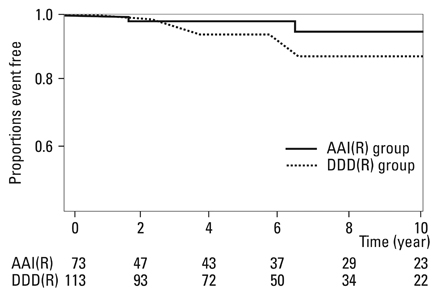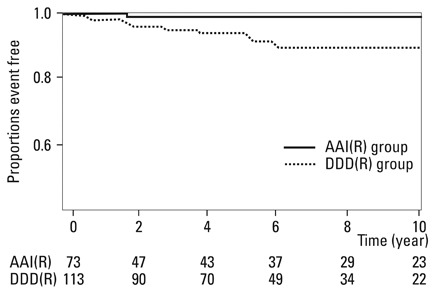Yonsei Med J.
2010 Nov;51(6):832-837. 10.3349/ymj.2010.51.6.832.
Long-Term Outcome of Single-Chamber Atrial Pacing Compared with Dual-Chamber Pacing in Patients with Sinus-Node Dysfunction and Intact Atrioventricular Node Conduction
- Affiliations
-
- 1Division of Cardiology, Eulji University Hospital, Eulji University School of Medicine, Daejeon, Korea.
- 2Division of Cardiology, Yonsei Cardiovascular Center and Cardiovascular Research Institute, Yonsei University College of Medicine, Seoul, Korea. mhlee@yuhs.ac
- KMID: 1779627
- DOI: http://doi.org/10.3349/ymj.2010.51.6.832
Abstract
- PURPOSE
The optimal pacing mode with either single chamber atrial pacemaker (AAI or AAIR) or dual chamber pacemaker (DDD or DDDR) is still not clear in sinus-node dysfunction (SND) and intact atrioventricular (AV) conduction.
MATERIALS AND METHODS
Patients who were implanted with permanent pacemaker using AAI(R) (n = 73) or DDD(R) (n = 113) were compared.
RESULTS
The baseline characteristics were comparable between the two groups, with a mean follow-up duration of 69 months. The incidence of death did not show statistical difference. However, the incidence of hospitalization for congestive heart failure (CHF) was significantly lower in the AAI(R) group (0%) than the DDD(R) group (8.8%, p = 0.03). Also, atrial fibrillation (AF) was found in 2.8% in the AAI(R) group, which was statistically different from 15.2% of patients in the DDD(R) group (p = 0.01). Four patients (5.5%) with AAI(R) developed AV block, and subsequently switched to DDD(R) pacing. The risk of AF was lower in the patients implanted with AAI(R) than those with DDD(R) [hazard ratio (HR), 0.84; 95% confidence interval, 0.72 to 0.97, p = 0.02].
CONCLUSION
In patients with SND and intact AV conduction, AAI(R) pacing can achieve a better clinical outcome in terms of occurrence of CHF and AF than DDD(R) pacing. These findings support AAI(R) pacing as the preferred pacing mode in patients with SND and intact AV conduction.
MeSH Terms
-
Aged
Atrial Fibrillation/complications/physiopathology
Atrioventricular Node/*physiopathology
Cardiac Pacing, Artificial
Cohort Studies
Female
Follow-Up Studies
Heart Failure/complications
Humans
Male
Middle Aged
Proportional Hazards Models
Retrospective Studies
Sick Sinus Syndrome/*physiopathology
Treatment Outcome
Figure
Cited by 1 articles
-
Early Experience Using a Left Atrial Appendage Occlusion Device in Patients with Atrial Fibrillation
Yung Ly Kim, Boyoung Joung, Young Keun On, Chi Young Shim, Moon Hyoung Lee, Young-Hoon Kim, Hui-Nam Pak
Yonsei Med J. 2012;53(1):83-90. doi: 10.3349/ymj.2012.53.1.83.
Reference
-
1. Lamas GA, Pashos CL, Normand SL, McNeil B. Permanent pacemaker selection and subsequent survival in elderly Medicare pacemaker recipients. Circulation. 1995. 91:1063–1069.
Article2. Healey JS, Toff WD, Lamas GA, Andersen HR, Thorpe KE, Ellenbogen KA, et al. Cardiovascular outcomes with atrial-based pacing compared with ventricular pacing: meta-analysis of randomized trials, using individual patient data. Circulation. 2006. 114:11–17.
Article3. Andersen HR, Nielsen JC, Thomsen PE, Thuesen L, Vesterlund T, Pedersen AK, et al. Atrioventricular conduction during long-term follow-up of patients with sick sinus syndrome. Circulation. 1998. 98:1315–1321.
Article4. Nielsen JC, Kristensen L, Andersen HR, Mortensen PT, Pedersen OL, Pedersen AK. A randomized comparison of atrial and dual-chamber pacing in 177 consecutive patients with sick sinus syndrome: echocardiographic and clinical outcome. J Am Coll Cardiol. 2003. 42:614–623.
Article5. Masumoto H, Ueda Y, Kato R, Usui A, Maseki T, Takagi Y, et al. Long-term clinical performance of AAI pacing in patients with sick sinus syndrome: a comparison with dual-chamber pacing. Europace. 2004. 6:444–450.
Article6. Santini M, Alexidou G, Ansalone G, Cacciatore G, Cini R, Turitto G. Relation of prognosis in sick sinus syndrome to age, conduction defects and modes of permanent cardiac pacing. Am J Cardiol. 1990. 65:729–735.
Article7. Andersen HR, Nielsen JC, Thomsen PE, Thuesen L, Mortensen PT, Vesterlund T, et al. Long-term follow-up of patients from a randomized trial of atrial versus ventricular pacing for sick-sinus syndrome. Lancet. 1997. 350:1210–1216.
Article8. Brandt J, Anderson HR, Fåhraeus T, Schüller H. Natural history of sinus-node disease treated with atrial pacing in 213 patients: implications for selection of stimulation mode. J Am Coll Cardiol. 1992. 20:633–639.
Article9. Haywood GA, Ward J, Ward DE, Camm AJ. Atrioventricular Wenckebach point and progression to atrioventricular block in sinoatrial disease. Pacing Clin Electrophysiol. 1990. 13:2054–2058.
Article10. Hatano K, Kato R, Hayashi H, Noda S, Sotobata I, Murase M. Usefulness of rate responsive atrial pacing in patients with sick sinus syndrome. Pacing Clin Electrophysiol. 1989. 12:16–24.
Article11. Kristensen L, Nielsen JC, Mortensen PT, Pedersen OL, Pedersen AK, Andersen HR. Incidence of atrial fibrillation and thromboembolism in a randomised trial of atrial versus dual chamber pacing in 177 patients with sick sinus syndrome. Heart. 2004. 90:661–666.
Article12. Leclercq C, Gras D, Le Helloco A, Nicol L, Mabo P, Daubert C. Hemodynamic importance of preserving the normal sequence of ventricular activation in permanent cardiac pacing. Am Heart J. 1995. 129:1133–1141.13. Lee MA, Dae MW, Langberg JJ, Griffin JC, Chin MC, Finkbeiner WE, et al. Effects of long-term right ventricular apical pacing on left ventricular perfusion, innervation, function and histology. J Am Coll Cardiol. 1994. 24:225–232.14. Rosenqvist M, Isaaz K, Botvinick EH, Dae MW, Cockrell J, Abbott JA, et al. Relative importance of activation sequence compared to atrioventricular synchrony in left ventricular function. Am J Cardiol. 1991. 67:148–156.
Article15. Sweeney MO, Hellkamp AS, Ellenbogen KA, Greenspon AJ, Freedman RA, Lee KL, et al. Adverse effect of ventricular pacing on heart failure and atrial fibrillation among patients with normal baseline QRS duration in a clinical trial of pacemaker therapy for sinus node dysfunction. Circulation. 2003. 107:2932–2937.
Article16. Tsai SH, Lin YY, Chu SJ, Hsu CW, Cheng SM. Interpretation and use of natriuretic peptides in non-congestive heart failure settings. Yonsei Med J. 2010. 51:151–163.
Article17. Nielsen JC, Bøttcher M, Nielsen TT, Pedersen AK, Andersen HR. Regional myocardial blood flow in patients with sick sinus syndrome randomized to long-term single chamber atrial or dual chamber pacing-effect of pacing mode and rate. J Am Coll Cardiol. 2000. 35:1453–1461.
Article18. Adomian GE, Beazell J. Myofibrillar disarray produced in normal hearts by chronic electrical pacing. Am Heart J. 1986. 112:79–83.
Article19. van Oosterhout MF, Prinzen FW, Arts T, Schreuder JJ, Vanagt WY, Cleutjens JP, et al. Asynchronous electrical activation induces asymmetrical hypertrophy of the left ventricular wall. Circulation. 1998. 98:588–595.20. Connolly SJ, Kerr CR, Gent M, Roberts RS, Yusuf S, Gillis AM, et al. Canadian Trial of Physiologic Pacing Investigators. Effects of physiologic pacing versus ventricular pacing on the risk of stroke and death due to cardiovascular causes. N Engl J Med. 2000. 342:1385–1391.
Article21. Lamas GA, Lee KL, Sweeney MO, Silverman R, Leon A, Yee R, et al. Ventricular pacing or dual-chamber pacing for sinus-node dysfunction. N Engl J Med. 2002. 346:1854–1862.
Article22. Toff WD, Camm AJ, Skehan JD. United Kingdom Pacing and Cardiovascular Events Trial Investigators. Single-chamber versus dual-chamber pacing for high-grade atrioventricular block. N Engl J Med. 2005. 353:145–155.
Article23. Greenspon AJ, Hart RG, Dawson D, Hellkamp AS, Silver M, Flaker GC, et al. Predictors of stroke in patients paced for sick sinus syndrome. J Am Coll Cardiol. 2004. 43:1617–1622.
Article
- Full Text Links
- Actions
-
Cited
- CITED
-
- Close
- Share
- Similar articles
-
- Usefulness of Activity: Sensing Rate Responsive Pacemaker
- Incidence of Atrial Fibrillation and Cerebral Stroke in Patients Treated with Ventricular Pacing and Dual-Chamber Pacing
- Clinical Investigation of P Wave Amplitude and Atrial Synchronous Ventricular Pacing in Different Body Position and Physical Activity with a Single-Pass Lead VDD Pacing
- Long-term Follow-up of the Patients with Permanent Antibradycardia Pacemaker
- Electrophysiologic Properties of the AV Conduction System in Patients with Sinus Node Dysfunction




